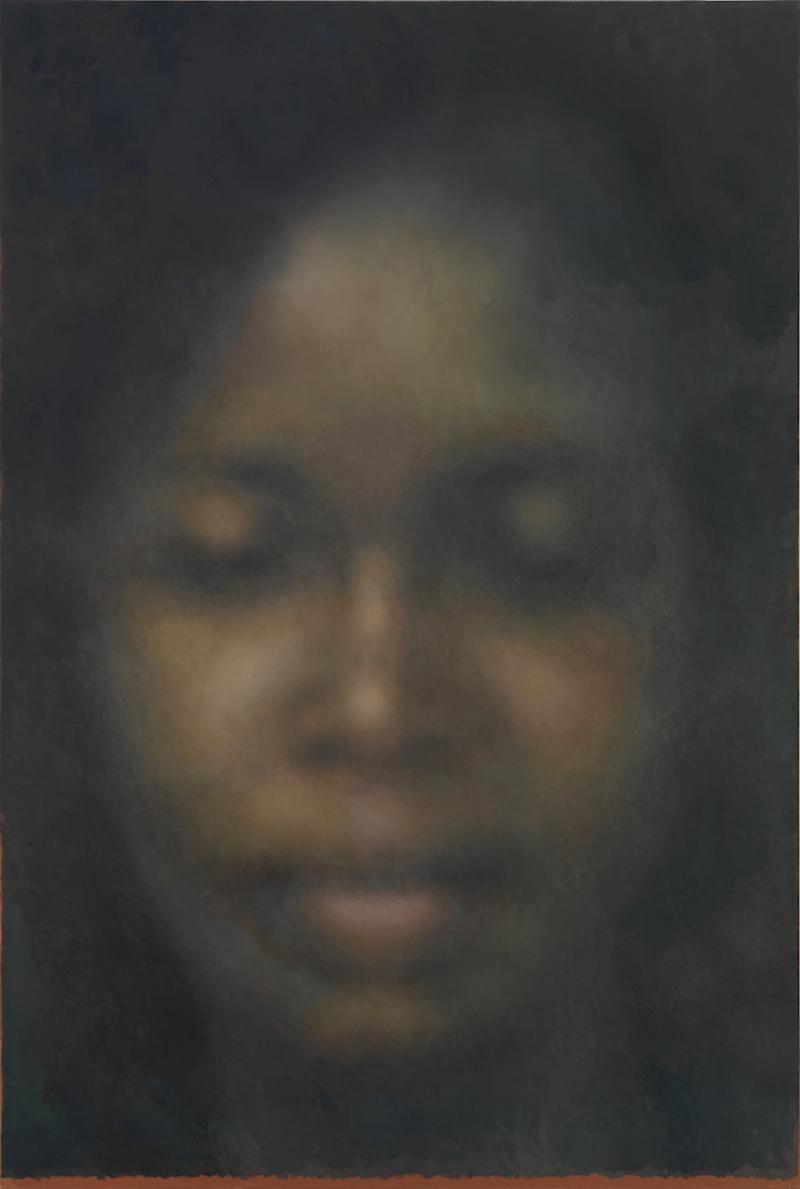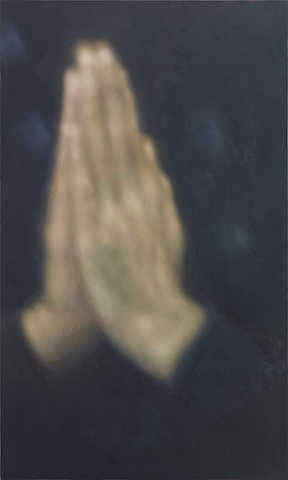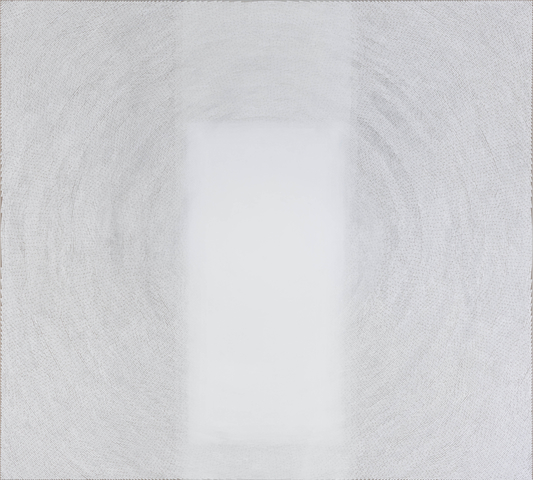YZ Kami, Gagosian Gallery | reviews, news & interviews
YZ Kami, Gagosian Gallery
YZ Kami, Gagosian Gallery
Hypnotically arresting portrait and abstract paintings that play with variation and repetition

The Iranian-born New York resident painter YZ Kami, now in his mid-fifties, continually plays with our hunger to look at “reality” while being seduced by abstraction and repetition. In 17 canvases, painted over the past two years, Kami explores two distinct and recognisable styles or idioms that however much in common they have with contemporary concerns he has made his own. The results are both powerful and pleasurable.
He uses oil on linen when painting blurred portraits based on photographs or, presumably when the subject is named, based on a person known to the artist; acrylic on canvas when dealing with swirling abstract patterns. In ways both subtle and obvious, each subject, representational or abstract, deals with themes and variations, as well as suggesting ways of looking beyond what we actually see, to ponder on issues beyond the visible.
The nine portraits, of subjects young and older, the heads perhaps five or six times or more life size, at times have their eyes downcast, at times, as with The Man with Violet Eyes, look straight out. The work is nine feet tall and six wide, and yet, curiously, not overwhelming so much as approachable, as though the young man looking out, just his face and the top of his bright, almost luminous, T-shirt visible, is about to speak. He is serious but not solemn. We are disarmed because the subject is so ordinary, someone to whom we might not give a second glance. But here, the scale, the skilled blurring of the image, and the range of blended colour, is inescapably arresting without being in any way melodramatic.
 The artist’s mother is another subject; she is quietly beautiful, even more so because it is not blatant good looks but rather a fascinating calm. The image is obviously from memory or a photograph taken when younger. Again the pose is modest. The size of the portraits makes them imposing, but the subject possesses a quiet reticence, a curious self-effacement but with no false humility. These images are dignified, but not irritatingly so: there is no apparent smugness, just a sense of containment.
The artist’s mother is another subject; she is quietly beautiful, even more so because it is not blatant good looks but rather a fascinating calm. The image is obviously from memory or a photograph taken when younger. Again the pose is modest. The size of the portraits makes them imposing, but the subject possesses a quiet reticence, a curious self-effacement but with no false humility. These images are dignified, but not irritatingly so: there is no apparent smugness, just a sense of containment.
Occasionally, there's no neckline, no visible clothing underlining the flesh tones; one such is Ava (main picture), a bronze-black face, strongly delineated, against an even darker background. The face is almost mask-like, but also serene: inexplicably Ava exudes a sense of comfort, even security. The women in Kami’s portrayals are impassive, but not passive; they look as though they know a thing or two, but without being knowing. Watchful. In fact. like all fine portraits, we can project a range of emotions, but mostly we understand they are looking inward. The young men – Daya in Profile, for example – seem fresh-faced and a little uncertain.
One painting is of just two hands clasped together in the conventional pose of prayer, a subject so resonant, so frequent, that it is almost impossible to shed a conventional reaction that is partly almost resentfully agnostic. These, the title tells us, are Daya’s Hands, 2014 (pictured above left). Are they clasped and pointing upwards in supplication? Is this an act of respect or an act of worship? Somehow the more you look the more any interpretation shivers into ambiguity.
 One gallery contains a sequence of abstractions in which circles of uneven white geometric shapes – like rectangular bricks, or squares, seemingly painted free-hand – surround a central circular void. The generic title is White Dome (pictured right: White Dome I, 2011-13), and in their revolving rhythms they oddly echo that master of the overall white painting, Robert Ryman, as though on speed. They somehow seem to be absolutely still, making a fascinating pattern, and also in movement, directing the eye to the central white space. One variation is in black. The effect is that of a kind of mandala; the large size – approximately eight by nine feet – means they can easily take over our field of vision. It is also almost a game to see the infinite variations possible, with each visual unit offering almost miniscule variations in size and texture. These series of tiny inflections are the opposite of mechanical.
One gallery contains a sequence of abstractions in which circles of uneven white geometric shapes – like rectangular bricks, or squares, seemingly painted free-hand – surround a central circular void. The generic title is White Dome (pictured right: White Dome I, 2011-13), and in their revolving rhythms they oddly echo that master of the overall white painting, Robert Ryman, as though on speed. They somehow seem to be absolutely still, making a fascinating pattern, and also in movement, directing the eye to the central white space. One variation is in black. The effect is that of a kind of mandala; the large size – approximately eight by nine feet – means they can easily take over our field of vision. It is also almost a game to see the infinite variations possible, with each visual unit offering almost miniscule variations in size and texture. These series of tiny inflections are the opposite of mechanical.
The artist’s last and only exhibition in London, at Parasol Unit in 2008, was shown under the general title of Endless Prayers. Kami’s intent is, it seems, both in the portraits of people and in the sequence of inventive abstract patterns, to make us attentive, to make us look beyond. People and pattern become familiar, and we are lulled and soothed. But each person is markedly different, and each pattern also, and each distinctly recognisable. The procession of his paintings becomes almost hypnotically fascinating.
Explore topics
Share this article
The future of Arts Journalism
You can stop theartsdesk.com closing!
We urgently need financing to survive. Our fundraising drive has thus far raised £33,000 but we need to reach £100,000 or we will be forced to close. Please contribute here: https://gofund.me/c3f6033d
And if you can forward this information to anyone who might assist, we’d be grateful.

Subscribe to theartsdesk.com
Thank you for continuing to read our work on theartsdesk.com. For unlimited access to every article in its entirety, including our archive of more than 15,000 pieces, we're asking for £5 per month or £40 per year. We feel it's a very good deal, and hope you do too.
To take a subscription now simply click here.
And if you're looking for that extra gift for a friend or family member, why not treat them to a theartsdesk.com gift subscription?
more Visual arts
 Help to give theartsdesk a future!
Support our GoFundMe appeal
Help to give theartsdesk a future!
Support our GoFundMe appeal
 Do Ho Suh: Walk the House, Tate Modern review - memories are made of this
Home sweet home preserved as exquisite replicas
Do Ho Suh: Walk the House, Tate Modern review - memories are made of this
Home sweet home preserved as exquisite replicas
 Ed Atkins, Tate Britain review - hiding behind computer generated doppelgängers
Emotions too raw to explore
Ed Atkins, Tate Britain review - hiding behind computer generated doppelgängers
Emotions too raw to explore
 Echoes: Stone Circles, Community and Heritage, Stonehenge Visitor Centre review - young photographers explore ancient resonances
The ancient monument opens its first exhibition of new photography
Echoes: Stone Circles, Community and Heritage, Stonehenge Visitor Centre review - young photographers explore ancient resonances
The ancient monument opens its first exhibition of new photography
 Hylozoic/Desires: Salt Cosmologies, Somerset House and The Hedge of Halomancy, Tate Britain review - the power of white powder
A strong message diluted by space and time
Hylozoic/Desires: Salt Cosmologies, Somerset House and The Hedge of Halomancy, Tate Britain review - the power of white powder
A strong message diluted by space and time
 Mickalene Thomas, All About Love, Hayward Gallery review - all that glitters
The shock of the glue: rhinestones to the ready
Mickalene Thomas, All About Love, Hayward Gallery review - all that glitters
The shock of the glue: rhinestones to the ready
 Interview: Polar photographer Sebastian Copeland talks about the dramatic changes in the Arctic
An ominous shift has come with dark patches appearing on the Greenland ice sheet
Interview: Polar photographer Sebastian Copeland talks about the dramatic changes in the Arctic
An ominous shift has come with dark patches appearing on the Greenland ice sheet
 Donald Rodney: Visceral Canker, Whitechapel Gallery review - absence made powerfully present
Illness as a drive to creativity
Donald Rodney: Visceral Canker, Whitechapel Gallery review - absence made powerfully present
Illness as a drive to creativity
 Noah Davis, Barbican review - the ordinary made strangely compelling
A voice from the margins
Noah Davis, Barbican review - the ordinary made strangely compelling
A voice from the margins
 Best of 2024: Visual Arts
A great year for women artists
Best of 2024: Visual Arts
A great year for women artists
 Electric Dreams: Art and Technology Before the Internet, Tate Modern review - an exhaustive and exhausting show
Flashing lights, beeps and buzzes are diverting, but quickly pall
Electric Dreams: Art and Technology Before the Internet, Tate Modern review - an exhaustive and exhausting show
Flashing lights, beeps and buzzes are diverting, but quickly pall
 ARK: United States V by Laurie Anderson, Aviva Studios, Manchester review - a vessel for the thoughts and imaginings of a lifetime
Despite anticipating disaster, this mesmerising voyage is full of hope
ARK: United States V by Laurie Anderson, Aviva Studios, Manchester review - a vessel for the thoughts and imaginings of a lifetime
Despite anticipating disaster, this mesmerising voyage is full of hope

Add comment